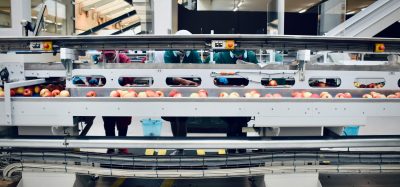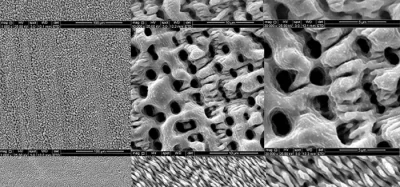Re-adhesion of bacterial spores during CIP procedures
- Like
- Digg
- Del
- Tumblr
- VKontakte
- Buffer
- Love This
- Odnoklassniki
- Meneame
- Blogger
- Amazon
- Yahoo Mail
- Gmail
- AOL
- Newsvine
- HackerNews
- Evernote
- MySpace
- Mail.ru
- Viadeo
- Line
- Comments
- Yummly
- SMS
- Viber
- Telegram
- Subscribe
- Skype
- Facebook Messenger
- Kakao
- LiveJournal
- Yammer
- Edgar
- Fintel
- Mix
- Instapaper
- Copy Link
Posted: 15 December 2010 | Christine Faille, INRA, UR638 Interface processes and hygiene of materials | No comments yet
Cleaning In Place (CIP) procedures have to ensure hygiene in food processing lines by the complete removal of bacteria from surfaces. However, a significant number of residual microorganisms are often still observed following CIP. At INRA, we put forward the hypothesis that some of the detached micro-organisms might re-adhere downstream. Therefore, we investigated the occurrence of this phenomenon along a processing line and evaluated the extent of the re-adhesion.
Cleaning In Place (CIP) procedures have to ensure hygiene in food processing lines by the complete removal of bacteria from surfaces. However, a significant number of residual microorganisms are often still observed following CIP. At INRA, we put forward the hypothesis that some of the detached micro-organisms might re-adhere downstream. Therefore, we investigated the occurrence of this phenomenon along a processing line and evaluated the extent of the re-adhesion.
Cleaning In Place (CIP) procedures have to ensure hygiene in food processing lines by the complete removal of bacteria from surfaces. However, a significant number of residual microorganisms are often still observed following CIP. At INRA, we put forward the hypothesis that some of the detached micro-organisms might re-adhere downstream. Therefore, we investigated the occurrence of this phenomenon along a processing line and evaluated the extent of the re-adhesion.
Micro-organisms commonly found to be associated with equipment surfaces in various industrial environments include bacteria belonging to the genus Bacillus. These are of concern in food industries as some species, such as B. cereus, are often incriminated in foodborne diseases and are able to induce food spoilage, generating major economic consequences. The persistence of these germs in the food environment largely results from their ability to produce spores. Indeed, Bacillus spores are highly resistant to most of the treatments devised by food producers to limit bacterial survival and growth, such as pasteurisation or disinfection treatments. Furthermore, spores can adhere firmly to a variety of materials found in the food environment, such as stainless steel1. Lastly, adherent spores can resist cleaning procedures, as shown by Hüsmark & Rönner2, who demonstrated that a significant number of adherent spores (approximately 40 per cent) were not removed by usual cleaning procedures.
B. cereus is also able to form biofilms3, which would appear to be responsible for the high concentration of cells sometimes found in processing lines, downstream of the pasteurisation area. Many works have reported on the increased resistance of those bacteria embedded in biofilms to cleaning and disinfection procedures. More interestingly, sporulation has been proven to occur inside biofilms, sometimes at very high levels.
Cleaning kinetics
The cleaning of contaminated surfaces is of course a complex phenomenon, whose efficiency relies on the soil composition and structure, but also on operating conditions, e.g. the nature and concentration of chemicals, and the temperature and time of treatment. Cleaning efficiency is also deeply affected by the processing line, due to the major role of the hydrodynamics in soil detachment. For example, irregularities of the equipment surfaces (material topography, presence of welds, gaskets) might provide protection against wall shear stresses4. Furthermore, the design of the processing lines and equipment would affect flow conditions5. Today, existing literature provides much information on the cleaning kinetics of food soiling, such as milk or calcium salts. The removal kinetics have often been modelled by a first degree kinetic, but some authors have shown that different phenomena would work jointly. Gallot-Lavallée et al6, for example, distinguish chemical action (zero-order equation) from flow mechanical action in the detachment of milk soil.
Concerning bacterial soiling, only a few results have been reported: a first-order equation was first proposed by Dickinson et al7 to model removal kinetics, the removal rate constant depending on the shear stress applied. It is noteworthy that most of these studies were carried out in laboratories devices, often far from conditions found in the food industry. More recently, some results have been reported in literature from experiments performed in conditions close to those encountered in food processing lines. A CIP model was chosen, which involves the use of sodium hydroxide (NaOH), due to its extensive use in the food industries, e.g. in dairies. The experimental conditions (NaOH 0.5 per cent, 60°C) were also chosen to be relevant with industrial conditions and to induce a detachment rate slow enough to allow the analysis of the detachment kinetics. Indeed, the NaOH concentration of 0.5 per cent has been reported to be efficient in milk soil removal, while a temperature of 60°C can often be found in complex equipment. In order to limit flow disturbances, a set of pipes was placed upstream of the test pipes.
In these experimental conditions, cleaning kinetics of stainless steel pipes (grade 304 or 316, finish 2B, average roughness around 0.3 μm) soiled with B. cereus spores were analysed. Cleaning kinetics were monitored in various experimental conditions: water vs NaOH, different temperatures and flow conditions8. As shown in Figure 1, the initial detachment rate of adherent spores was high, most of the adherent spores were detached during the first five or 10 minutes of cleaning. The number of adherent spores then slowly decreased to reach an asymptote. Indeed, a low but significant percentage of spores remained on the surface of the pipes after CIP, even under the most drastic conditions used in this study. This residual contamination was of course affected by temperature, presence of NaOH and wall shear stress. The lowest residual contamination level (around one per cent) was obtained after a 30 minute clean with NaOH 0.5 per cent at 60°C, at a wall shear stress of 70 Pa. Other works carried out in the laboratory showed that higher residual contamination levels could be observed. When a B. thuringiensis strain was used (a Bacillus species close to B. cereus), up to two per cent spores still adhered after 30 minutes cleaning (alkaline detergent at 50°C), at an average shear stress of over 120 Pa9. This variability between strains has recently been confirmed10 on three strains belonging to the B. cereus species. In similar conditions, residual levels of adherent spores were estimated as ranging from three to 13 per cent.
”]![fig 1 for web Figure 1 Modelling of experimental cleaning kinetics of pipes soiled with Bacillus cereus spores (20 Pa, 0.5 per cent NaOH, 60°C) in three conditions. In two conditions, the asymptote was reached within 30 minutes cleaning [Bénézech T., INRA UR638]](http://www.newfoodmagazine.com/wp-content/uploads/fig-1-for-web3.jpg)
![fig 1 for web Figure 1 Modelling of experimental cleaning kinetics of pipes soiled with Bacillus cereus spores (20 Pa, 0.5 per cent NaOH, 60°C) in three conditions. In two conditions, the asymptote was reached within 30 minutes cleaning [Bénézech T., INRA UR638]](http://www.newfoodmagazine.com/wp-content/uploads/fig-1-for-web3.jpg)
Identification of the re-adhesion phenomenon
From these observations, it was hypothesised that at least some of the detached spores were able to adhere again downstream, and that this ‘re-adhesion’ could at least partly explain the presence of residual contamination after a CIP procedure. For this purpose, a loop including highly contaminated pipes together with uncontaminated pipes was designed. As expected, the uncontaminated surfaces were contaminated during the cleaning procedure (Figure 2), indicating that a section of the detached spores were able to re-adhere downstream8. Consequently, adhesion and detachment phenomena in closed systems were concomitant and models based on a balance between spore removal and re-adhesion were therefore required, with two apparent rate constants (adhesion and detachment).
”]![fig 2 for web Figure 2 Re-adhesion in pipes of spores of two strains of B. cereus, detached during cleaning [Legentil C., INRA UR638]](http://www.newfoodmagazine.com/wp-content/uploads/fig-2-for-web4.jpg)
![fig 2 for web Figure 2 Re-adhesion in pipes of spores of two strains of B. cereus, detached during cleaning [Legentil C., INRA UR638]](http://www.newfoodmagazine.com/wp-content/uploads/fig-2-for-web4.jpg)
Role of the flow arrangement on the re-adhesion phenomenon
It was thus essential to determine whether the same mechanisms (e.g. flow patterns) governed both phenomena of Bacillus spore adhesion during food processing and spore re-adhesion during CIP procedures. For example, previous works have emphasised the importance of flow patterns, such as those found at areas directly after bends11 or in complex pieces of equipment12 on surface hygiene. Le Gentil et al.10 investigated if re-adhesion preferentially occurred in areas characterised by disturbed flow patterns. The uncontaminated pipes were located at various places known to be characterised by different flow arrangements, such as downstream of a bend or in a straight part of the rig. Indeed, as shown in Figure 3, the mean velocity profiles observed at different longitudinal positions x/d after the bend reveal a non axis-symmetric behaviour of the flow and a deformation of the velocity profiles, leading to recirculation in some areas: the maximum velocity does not occur at the tube centre core, but near the opposite coiled bend wall. The presence of flow disturbance downstream of a bend was shown to result in significantly higher re-adhesion rate (Figure 2), around 30 per cent higher than the contamination level found under fully developed flow. Furthermore, the same trend was observed whatever the Bacillus strain in use, characterised by various spore properties.
”]![fig 3 for web Figure 3Velocity profiles (filled symbols) and turbulence intensity (empty symbols) measured at different position after the curved bend (Re = 35 000 for 2.30 x 10-2 m pipe diameter). [Blel W., University of Nantes, CNRS, GEPEA, UMR 6144]](http://www.newfoodmagazine.com/wp-content/uploads/fig-3-for-web6.jpg)
![fig 3 for web Figure 3Velocity profiles (filled symbols) and turbulence intensity (empty symbols) measured at different position after the curved bend (Re = 35 000 for 2.30 x 10-2 m pipe diameter). [Blel W., University of Nantes, CNRS, GEPEA, UMR 6144]](http://www.newfoodmagazine.com/wp-content/uploads/fig-3-for-web6.jpg)
In order to determine the role of complex pieces of equipment on spore re-adhesion, a two-way valve was chosen. The results reported by Blel et al12 indicated that recirculation zones (for example the contraction and expansion zones at entries and exits) and zones characterised by low shear stresses result in enhanced residence times between materials and spores, further increasing contamination levels. Furthermore, most of these contaminated areas were still highly contaminated after the CIP procedure. According to the authors, this high residual contamination could be the result of low mean shear stresses values, but also of a possible re-deposition phenomenon. This hypothesis was confirmed by Le Gentil et al10. In the course of a CIP procedure, new contamination appeared preferentially in areas where recirculation occurred. Moreover, the contamination level was relatively high with the valve entries and exits being more contaminated than pipes.
Another work11 evidenced that even small surface irregularities such as those due to the presence of gaskets and welding zones would promote spore persistence during CIP procedures (Figure 4). Indeed, the velocity profiles and turbulence intensity measured close to the gaskets and the welding zones indicate both significant disturbance and attenuation of the velocity values along the axial flow direction. These conditions are thus also considered as very favourable for the mass transport from the solution and adhesion / re-adhesion of spores to the wall after sedimentation due to the flow deceleration.
”]![fig 4 for web Figure 4Velocity profiles (filled symbols), turbulence intensity (empty symbols) and mapping of adhering spores measured along the set up (Re = 5000 for 2.30 x 10-2 m pipe diameter). In green, the poorly soiled zones, in yellow, the moderately soiled zones and in red, the highly soiled zones. [Blel W., University of Nantes, CNRS, GEPEA, UMR 6144]](http://www.newfoodmagazine.com/wp-content/uploads/fig-4-for-web2.jpg)
![fig 4 for web Figure 4Velocity profiles (filled symbols), turbulence intensity (empty symbols) and mapping of adhering spores measured along the set up (Re = 5000 for 2.30 x 10-2 m pipe diameter). In green, the poorly soiled zones, in yellow, the moderately soiled zones and in red, the highly soiled zones. [Blel W., University of Nantes, CNRS, GEPEA, UMR 6144]](http://www.newfoodmagazine.com/wp-content/uploads/fig-4-for-web2.jpg)
These phenomena of spore re-deposition after detachment were discussed by Blel et al12 depending on the spores relaxation time and the different time scales of the turbulence, especially the Kolmogorov timescale.
Role of the spore properties on the re-adhesion phenomenon
It must be kept in mind that bacterial spores are living micro-organisms, despite their huge ability to resist stressful environmental conditions, and might be injured or even inactivated in the conditions found during CIP procedures. These conditions, far from those encountered during food processing, could also affect the spore surface properties and consequently their ability to adhere. Indeed, the ability of spores to adhere is strongly affected by their surface properties as suggested by the diversity observed in the spore surface properties and ability to adhere within Bacillus species and even between B. cereus strains1. For example, some spores of the B. subtilis species are surrounded by a polymeric layer of greater or lesser thickness (up to 100 nanometres). This is mainly composed of polysaccharides and provides the spores with a marked hydrophilic character and a low ability to contaminate surfaces. Conversely, the external surface of spores belonging to the B. cereus group (B. cereus, B. anthracis and B. thuringiensis) consists of a loose-fitting membrane called an exosporium (Figure 5A). The exosporium includes an external hair-like nap made of a glycoprotein, BclA13, directly in contact with the environment. It obviously plays a major role in the spores’ physico-chemical properties, such as their moderately to marked hydrophobic character. Some appendages are also found on the spore of some strains, mainly of the B. cereus species. Among the spore surface properties, the hydrophobic character as well as the presence of appendages or of a small exosporium would promote spore adhesion to stainless steel surfaces1.
”]![fig 5 for web Figure 5 Transmission electron microscopy on spore sections of B. cereus 98/4 after ruthenium staining. Spores untreated (A) or treated with two per cent NaOH at 80°C (B). [Faille C., INRA UR638]](http://www.newfoodmagazine.com/wp-content/uploads/fig-5-for-web1.jpg)
![fig 5 for web Figure 5 Transmission electron microscopy on spore sections of B. cereus 98/4 after ruthenium staining. Spores untreated (A) or treated with two per cent NaOH at 80°C (B). [Faille C., INRA UR638]](http://www.newfoodmagazine.com/wp-content/uploads/fig-5-for-web1.jpg)
However, the environmental conditions encountered during CIP (shear stresses, NaOH, high temperature) were aggressive enough to affect the spores’ surface properties14. As shown in Figure 5B, the most obvious changes induced by the presence of hot NaOH were degradation or even a loss of appendages, as well as deep modifications to the exosporium structure, especially with the destruction of the hair-like nap. These modifications came with a significant decrease in the ability of B. cereus spores to adhere. High shear stresses could also lead to damage to or sometimes the removal of exosporium of B. cereus spores. The observation by MET of spores treated by successive passages in a peristaltic pump15 clearly shows that the exosporium is injured, at least for some spores. The consequence of this exosporium removal was a decreased ability to adhere to stainless steel surfaces.
In conclusion, the various stresses encountered by spores during CIP tend to reduce the ability of spores to adhere to stainless steel. That could account for the relatively weak rate of re-adhesion observed in the rig during CIP.
Conclusion
The re-adhesion phenomenon in the course of CIP procedures is thus a reality and the level of this phenomenon is not negligible. Despite great differences in the environmental conditions during food processing and during CIP procedures, flow patterns still play a major role. Spore re-adhesion would be promoted in localised zones where recirculation or deceleration occurs. However, sporere- adhesion seems to be limited due spore surface injury induced by the specific environmental conditions encountered during CIP, mainly the contact with hot NaOH. Fortunately, hot NaOH is also very efficient in inactivating spores and bacterial vegetative cells in particular. As a consequence, most of the re-adherent spores would be unable to recontaminate any food with which they came into contact. Nevertheless, cleaning strategies should take into account the re-adhesion phenomenon to limit the risk of contamination by the process line.
Acknowledgements
These works has been granted by the Agence Nationale de la Recherche under the Programme National de Recherche en Alimentation et Nutrition Humaine, Project ‘ANR-05-PNRA-013, B. cereus’ and project ANR-07-PNRA-009, InterSpore, and by the Région Nord-Pas de Calais (France).
References
1. Faille, C., Lequette, Y., Ronse, A., Slomianny, C., Garénaux, E., Guerardel, Y., 2010a. Morphology and physico-chemical properties of Bacillus spores surrounded or not with an exosporium: Consequences on their ability to adhere to stainless steel. International Journal of Food Microbiology 143, 125-135
2. Hüsmark, U., Rönner, U., 1992. The influence of hydrophobic, electrostatic and morphologic properties on the adhesion of Bacillus spores. Biofouling 5, 335-344
3. Ryu, J.H., Beuchat, L.R., 2005. Biofilm formation and sporulation by Bacillus cereus on a stainless steel surface and subsequent resistance of vegetative cells and spores to chlorine, chlorine dioxide, and a peroxyacetic acid-based sanitizer. J.Food Prot. 68, 2614-2622
4. Jullien, C., Bénézech, T., Carpentier, B., Lebret, V., Faille, C., 2003. Identification of surface characteristics relevant to the hygienic status of stainless steel for the food industry. J. Food Eng. 56, 77-87
5. Blel, W., Benezech, T., Legentilhomme, P., Legrand, J., Le Gentil-Lelievre, C.L., 2007. Effect of flow arrangement on the removal of Bacillus spores from stainless steel equipment surfaces during a Cleaning In Place procedure. Chemical Engineering Science 62, 3798-3808
6. Gallot-Lavallee, T., Lalande, M., Corrieu, G., 1982. An optical method to study the kinetics of cleaning milk deposits by sodium hydroxide. Journal of Food Process Engineering 5, 131-143
7. Dickinson, R.B., Nagel, J.A., Proctor, R.A., Cooper, S.L., 1997. Quantitative comparison of shear-dependent Staphylococcus aureus adhesion to three polyurethane ionomer analogs with distinct surface properties. J. Biomed. Mater. Res. 36, 152-162
8. Lelièvre, C., Antonini, G., Faille, C., Bénézech, T., 2002. Cleaning in place : modelling of cleaning kinetics of pipes soiled by Bacillus spores assuming a balance between deposition and removal. Food and Bioproducts Processing
9. Faille, C., Dennin, L., Bellon-Fontaine, M.N., Bénézech, T., 1999. Cleanability of stainless steel surfaces soiled by Bacillus thuringiensis spores under various flow conditions. Biofouling 14, 143-151
10. Le Gentil, C., Sylla, Y., Faille, C., 2010. Bacterial re-contamination of surfaces of food processing lines during cleaning in place procedures. Journal of Food Engineering 96, 37-42
11. Blel, W., T., B., P., L., J., L., C., L.G.-L., 2008. Hygienic design: effect of hydrodynamics on the cleanability of a food processing line. AICHE J. 54, 2553-2566
12. Blel, W., Legentilhomme, P., Le Gentil-Lelievre, C., Faille, C., Legrand, J., Benezech, T., 2010. Cleanability study of complex geometries: Interaction between B. cereus spores and the different flow eddies scales. Biochemical Engineering Journal 49, 40-51
13. Sylvestre, P., Couture-Tosi, E., Mock, M., 2002. A collagen-like surface glycoprotein is a structural component of the Bacillus anthracis exosporium. Molecular Microbiology 45, 169-178
14. Faille, C., Sylla, Y., Le Gentil, C., Bénézech, T., Slomianny, C., Lequette, Y., 2010b. Viability and surface properties of spores subjected to a cleaning-in-place procedure. Consequences on their ability to contaminate surfaces of equipment. Food Microbiology 27, 769-776
15. Faille, C., Tauveron, G., Le Gentil-Lelièvre, C., Slomianny, C., 2007. Occurrence of Bacillus cereus spores with a damaged exosporium: Consequences on the spore adhesion on surfaces of food processing lines. Journal of Food Protection 70, 2346-2353
About the Author
Christine Faille
Christine Faille has a PhD from Compiègne University of Technology (UTC). She joined INRA in 1992 as research scientist in microbiology. She now heads the research unit UR638, Interface processes and hygiene of materials. Her main research area is bacterial adhesion in food environments, with focus on the surface properties of Bacillus spores, spore adhesion and cleaning mechanisms and more recently on biofilms.








